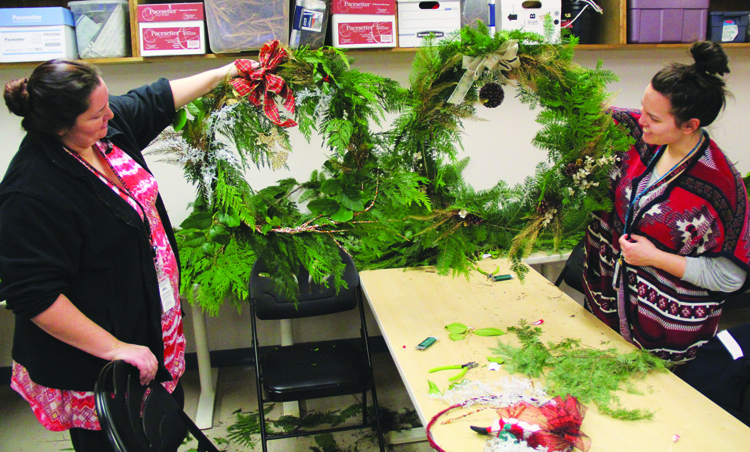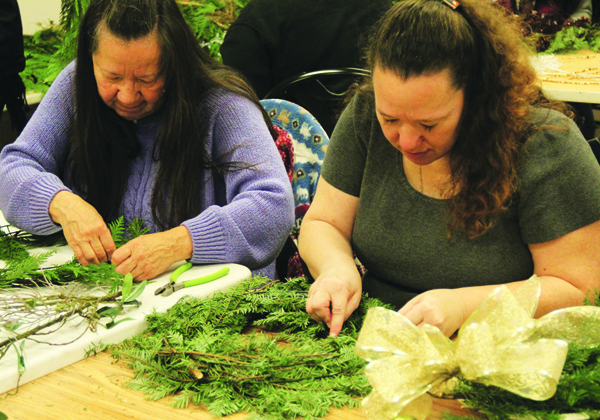
Photo/Micheal Rios
by Micheal Rios, Tulalip News
When you think of the holiday season, what do you think of? Is it time off from work? Is it family? Or is it about the gifts you still have to buy? For most of us it’s probably a combination of those answers, with the emphasis on the stuff you still have to buy. Our holiday season has become overshadowed by the materialism and appetite for consumerism that invades modern times. Not only are we buying stuff to give to people, buying holiday foods to eat, but we are also buying stuff to decorate our houses. For those who attended the 3rd annual Wreath Making Class, offered at the Tulalip Hibulb Cultural Center on December 10, they were able to celebrate the holiday season the traditional way; honoring the cause by creating a holiday wreath with family and friends that they chose to enjoy their time with.
In its third year, the wreath making event was coordinated by Inez Bill, Rediscovery Coordinator for the Hibulb Culture Center, Joy Lacy, Historic Records Curator, and Virginia Jones, Cultural Resources Secretary. They harvested resources such as cedar boughs, salal plants, holly, and ferns from the Tulalip woods that were used to make the holiday wreaths. Of having to go into the woods to harvest Joy Lacy said, “You forget about the little things in life until you get out in the woods and start gathering. It felt good being out in the woods. When you get back there you know what you are missing.”
Attendees of this year’s wreath making class were treated to a festive, communal gathering of Tulalip tribal members, tribal employees, and invited guests who came together with the common purpose of hand making a holiday wreath. “It’s my way of giving to the people. It’s an opportunity for people to make something, enjoy themselves, and to have something they’ve made by hand,” Inez Bill says of the wreath making class.
There was a variety of supplies on hand, so that each person could make their own unique wreath while creating connections with those around them. Even the creative novice would not have difficulty creating something to be proud of, as there was plenty of help and ideas to be offered by the event coordinators. The experience of creating something by hand, in such a welcoming, cheerful environment, makes the end result of having a wreath to giveaway as a gift or hang as a decoration so much more meaningful, something one simply can’t purchase from a retail store.
Among the attendees were three University of Washington students from the international and prestigious Restoration Ecology Network. They came to experience the ethnobotanical influence that the local environment has on traditional Tulalip activities. Inez Bill described the ethnobotancial influence of the wreath making class as being one of healing and keeping our connection to nature thriving.

Photo/Micheal Rios
“To me, I think anything you do working with your hands can be healing. Here, at Hibulb Cultural Center, we follow the teaching and values when we harvest anything. We only take what we need. We move area to area while harvesting. That way we aren’t wiping out one area. We value those traditional values and teachings. I think a lot of the plants that we harvest have medicinal values and other uses but at this time we are using them for wreaths. Cedar boughs have always been important to our people. You can brush yourself off with it. Some of the other plants, like salal, we use the berries from it. These plants we are familiar with. To go into nature and harvest them and have them here, we are hoping to keep that connection with nature in doing events like this for our people.”
Also in attendance were five members of the local Tulalip movement Unity in the Community. They spent approximately four hours in the wreath making class creating holiday wreaths to give to Tulalip elders. “We are community members that have the ability to respond and so we want to do what we can. Utilizing resources that are already given seemed like the easiest place to start,” remarked Tulalip tribal member Bibianna Anchetta.
Offered to all those who participated in the wreath making festivity was a complimentary lunch comprised of traditional Tulalip cuisine. Inez Bill used her own elk meat to cook up an elk stew with nettles, Terri Bagley made a huge batch of fry bread, and Virginia Jones provided blackberry nettle lemonade and blackberry pudding. The blackberry used was the wild ground blackberry native to Tulalip. The stinging nettle used in both the stew and lemonade was harvested this past spring. “It’s a plant and fiber source that our people have used for a lot of different things. It has a lot of nutritional value and is one of the strongest fibers that anyone can use. It is nice to be able to offer our people some of these local, traditional foods when we come together,” Bill says of the stinging nettle and blackberry ingredients.
The holiday season is supposed to be about being around people you care about and showing them you care about them. For Inez Bill and the staff of the Hibulb’s Rediscovery Program, not only did they offer a wreath making class that allowed community members and guests to come together, but they showed their class attendees how much they care for them by preparing a traditional Tulalip lunch. It’s all part of adhering to traditional Tulalip values and traditions, Bill explains.
“Respect and caring. That’s what we try to share with our people when we work with them. A lot of people have forgotten those values. We are here to share that with our tribal membership. Something that was taught a long time ago by aunties and grandmothers and grandfathers we teach here, those teachings and values. Here we can keep that connection and share that connection to nature with our people. This is a living culture.”
